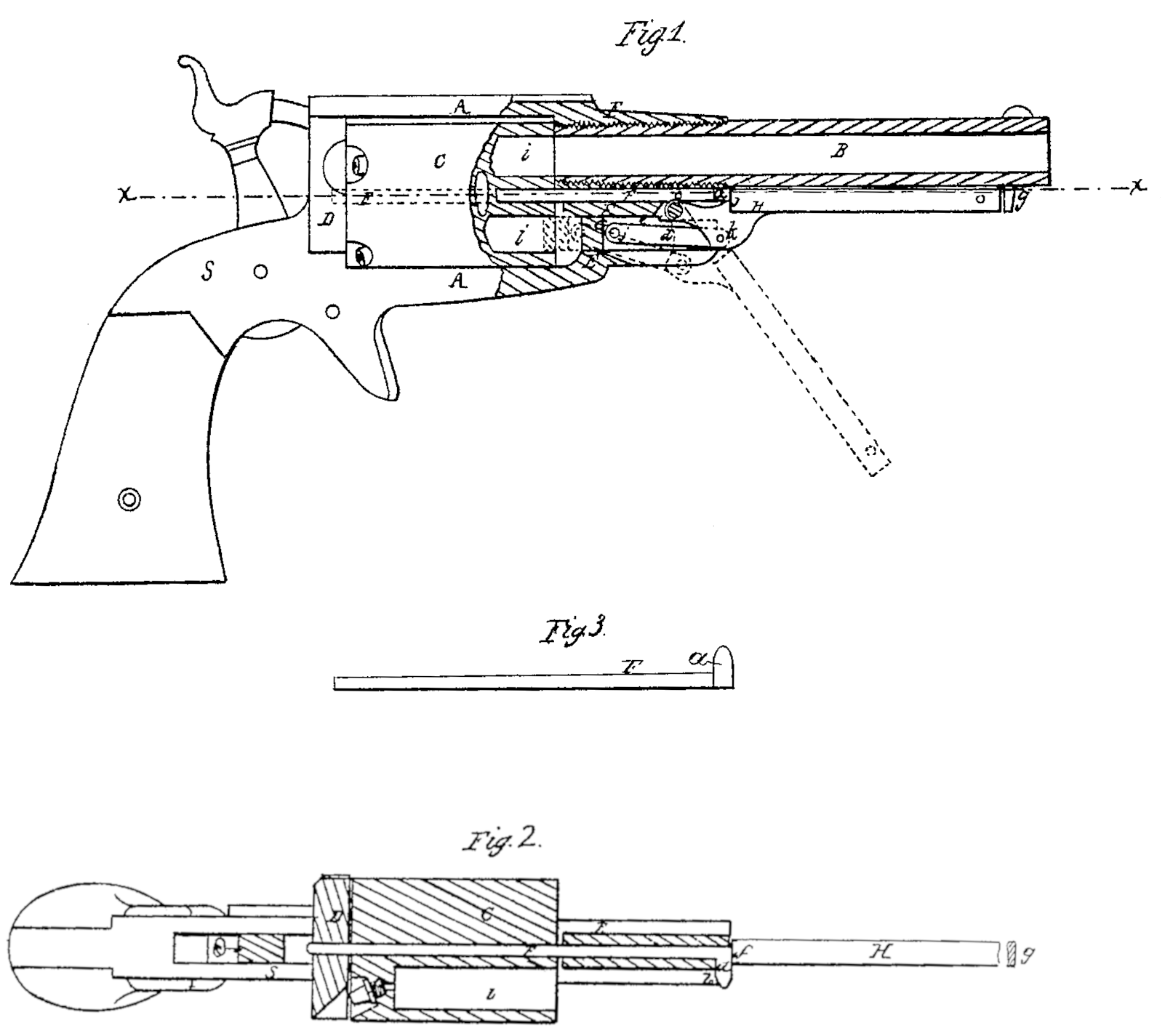US 21478
UNITED STATES PATENT OFFICE.
FORDYCE BEALS, OF NEW HAVEN, CONNECTICUT.
IMPROVEMENT IN REVOVING FIRE-ARMS.
Specification forming part of Letters Patent No. 21,478, dated September 14, 1858.
To all whom it may concern:
Be it known that I, Fordyce Beals, of New Haven, in the county of New Haven and State of Connecticut, have invented a new and useful Improvement in that class of Fire-Arms known as “Revolvers;” and I do hereby declare that the following is a full, clear, and exact description of the same, reference being had to the accompanying drawings, making part of this specification, in which—
Figure 1 is a longitudinal or side view, partly in section, of a pistol with my improvement. Fig. 2 is a horizontal section in the plane indicated by the line x x of Fig. 1, shown as it would be seen looking downward. Fig. 3 is a view of the center-pin on which the cylinder rotates.
Similar letters of reference indicate corresponding parts in the several figures.
This invention relates to that kind of revolver the axis of whose rotating many-chambered cylinder is arranged parallel with the bore of the barrel.
It consists in so constructing, applying, and arranging the center-pin on which the cylinder rotates and the lever which operates the rammer that the said pin is secured in place by a shoulder provided for the purpose on said lever when said lever is brought to a position close under the barrel, and that said pin can be withdrawn to allow the cylinder to be taken out when said lever is moved down to a position not far enough from the barrel to let the rammer interfere with the cylinder.
To enable others skilled in the art to apply my invention, I will proceed to describe its construction and operation.
A D E is the cylinder-frame, which contains the cylinder C, made in a piece with the principal portion of the stock S.
B is the barrel, which screws into the front part, E, of the frame A D E.
F is the center-pin on which the cylinder rotates, inserted through a hole provided for it in the front part, E, of the same and entering another hole in the back part or recoil shield, D. This pin is fitted snugly into the frame, but so that it can be withdrawn easily in a forward direction. It is provided with a head, a, at one side of its front end, which head is received in a notch, b, in one side of the front part, E, of the cylinder-frame, and thereby prevents the pin turning.
G is the rammer, arranged in the usual manner to slide in a hole bored for it in the front part, E, of the cylinder-frame.
EI is the lever by which the hammer is operated, partly working in a slot in the front part, E, of the cylinder-frame on a fulcrum-pin, c, which passes transversely through E, between the center-pin F and the rammer G, and connected with the rammer by a link, d, which is connected by two pins, j k, and works in a slot, e, in the rammer.
f is the shoulder on the rammer-lever H, for securing the center-pin in place, said shoulder coming against the head a of the center-pin, as shown in Fig.2 and in black outline in Fig. 1, when said lever lies close against the bottom of the barrel, in which position the lever is secured by a snap-piece, g, under the front part of the barrel, in a manner well known. The fulcrum-pin c is arranged far enough in front of the cylinder and the rammer so arranged that there is enough play between the latter and the front of the cylinder to permit the lever to be moved down far enough, as shown in Fig. 1 in red outline, to bring the shoulder f out of the way of the center-pin without moving the rammer far enough back to interfere with the cylinder. When the lever is in the last-mentioned position the center-pin can be withdrawn and the cylinder then be removed sidewise from the frame. By pulling the lever farther down when the cylinder and center-pin are in place, the rammer may be driven into the chambers i i on their being severally brought opposite to it by turning the cylinder by hand when the hammer is at half-cock.
The other parts of the weapon not herein specified may be constructed and applied after the manner of the corresponding parts in other revolvers.
What I claim as my invention, and desire to secure by Letters Patent, is—
Constructing, applying, and arranging the center-pin F and the rammer-lever E, substantially as described, so that the former is locked in place by the latter when the latter is close to the barrel, and that the former is permitted to be withdrawn by bringing the latter to a position in which the rammer will not interfere with the cylinder.
FORDYCE BEALS.
Witnesses:
Charles Ives,
Curtis S. Bushnell.

